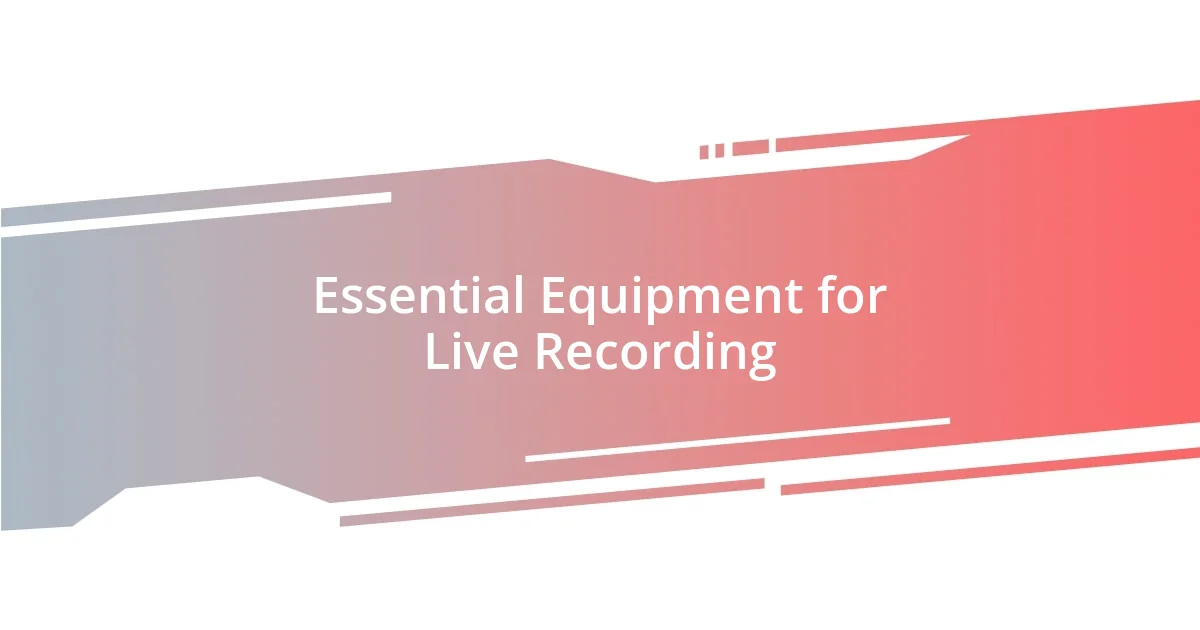Key takeaways:
- Microphone placement and type significantly impact sound quality; experimenting with different mics can transform recordings.
- Effective setup of the recording space, including acoustic treatment and cable management, enhances audio quality and inspires creativity.
- Post-production techniques, like careful editing and adding effects, are crucial for balancing live performances and enriching the final recording while maintaining authenticity.

Understanding Live Recording Setups
When diving into live recording setups, I can’t help but think about the first time I stepped into a studio filled with equipment I’d only seen in online tutorials. The sheer complexity of microphones, mixers, and interfaces was overwhelming, but it also sparked an excitement in me. It became clear that understanding these tools is crucial; they each play a vital role in capturing the essence of a performance.
One aspect I found fascinating was the significance of mic placement. I recall experimenting with different distances and angles during a live session, and the difference was astonishing. It made me wonder, how does something so seemingly simple create such a profound impact on the final sound? Each adjustment felt like unveiling a new layer of the music, which deepened my appreciation for the meticulous nature of recording.
Additionally, the integration of technology—like digital audio workstations—opened up a world of possibilities. I remember the thrill of piecing together a performance, layering tracks to enhance the overall sound. It prompted me to ask myself, how does technology reshape our creativity? Reflecting on those moments, it’s clear that understanding live recording setups isn’t just about the gear; it’s about how we use it to bring our artistic visions to life.

Essential Equipment for Live Recording
When it comes to essential equipment for live recording, the foundational element is undoubtedly the microphone. During my early sessions, I experimented with various types, from dynamic to condenser microphones, and learned that each type offers its own strengths. For example, I found that dynamic mics are great for loud environments because they handle high sound pressure levels well, while condenser mics capture finer nuances, ideal for softer vocals. It’s fascinating how choosing the right mic can completely transform the recording atmosphere.
Then, we have audio interfaces, a piece of equipment I initially overlooked. I remember the first time I connected an interface to my laptop, and it felt like unlocking a treasure chest of sound quality. The clarity and richness in the recordings were instantly noticeable. Interfaces convert analog signals to digital ones, which means they serve as a bridge between the microphones and your recording software. Investing in a good interface is essential for achieving professional-grade sound, and honestly, I learned this through many trial-and-error sessions.
Lastly, let’s talk about mixers. I recall standing behind a mixer with a sea of knobs and faders; it was a bit intimidating at first. However, I soon realized that mixers are the heartbeat of live recording. They allow you to control levels, EQ, and effects in real-time, shaping the sound as it’s captured. Understanding how to navigate a mixer became second nature after a few projects, and it elevated my confidence in live settings.
| Equipment | Purpose |
|---|---|
| Microphones | Capture sound, vary in sensitivity and sound quality |
| Audio Interfaces | Convert analog signals to digital, improve sound quality |
| Mixers | Control levels, EQ, and effects for optimal sound |

Setting Up Your Recording Space
Setting up your recording space is an art form in itself. I remember the first time I arranged my home studio; I spent hours tweaking the layout until it felt just right. It became a ritual to identify the sweet spot where sound flowed harmoniously. I learned that the placement of every item—desk, monitors, and even the acoustic panels—can significantly affect audio quality. Trust me, investing that time into arranging everything can turn a good setup into a great one.
Here are some practical tips to consider while setting up your space:
- Choose the Right Room: A quiet space with minimal echoes or external noise works best.
- Control Reflections: Use curtains or acoustic panels to dampen sound reflections.
- Position Your Monitors Correctly: Place them at ear level and in a triangular formation with your listening position.
- Organize Cables: Keep your cables tidy to avoid a cluttered environment and potential sound interference.
- Monitor Your Levels: Regularly adjust your sound levels to prevent any unwanted peaks or distortion.
I truly believe that creating a comfortable and functional space not only enhances the recording quality but inspires creativity. Each time I walked into my studio, I felt that familiar buzz of anticipation. It’s that environment that fuels your passion and allows the magic of live sound to flourish.

Tips for Optimal Sound Quality
To achieve optimal sound quality, one must pay close attention to microphone placement. During one of my live sessions, I discovered that even slight adjustments in mic positioning could make a world of difference. I always remember hearing the vast improvement in tone when I moved the microphone just a few inches closer to the vocalist. It made me wonder how something so simple could have such a profound effect—have you ever moved a mic and felt that instant clarity wash over the sound?
Another key aspect is managing your room’s acoustics. The first time I recorded in a space adorned with wall panels, I was amazed at how much it softened harsh reflections. It became clear to me that treating your room is just as important as the gear you use. I’ve found that adding soft furnishings like rugs or curtains can help tame echoes, creating a warmer sound that can elevate your recordings significantly.
Don’t underestimate the importance of monitoring your levels during a live recording. Once, I got caught up in the excitement of a session and forgot to keep an eye on the meters, leading to some unpleasant distortions in the final mix. That experience taught me the importance of keeping your output levels in check, ensuring each instrument and vocal comes through crystal clear. Regularly checking those levels can save you from headaches later on—how do you stay vigilant in your own recording sessions?

Managing Technical Challenges
Managing technical challenges is where the real artistry of live recording comes into play. I can’t stress enough how important it is to be prepared for unexpected hiccups. I vividly recall a session when my audio interface malfunctioned right before a crucial performance. My heart raced as I frantically switched cables and reconnected everything. In moments like these, keeping a level head is essential—have you ever felt that rush of panic when technology doesn’t cooperate?
Another lesson I learned is the importance of having backup equipment on hand. Once, during a lively jam session, one of my microphones failed. Thankfully, I had a spare tucked away, and switching it out saved the take. It made me realize the value of preparation—not just in gear, but in mindset. I’ve found it’s best not to rely solely on the gear. How often do you think about contingency plans when you set up for a session?
Lastly, regular software updates can’t be overlooked. I once encountered glitches mid-stream due to an outdated plugin that made everything come to a screeching halt. Keeping everything updated seems like a no-brainer, but life gets busy, right? But trust me, taking that small step can prevent larger headaches, allowing you to focus more on your creativity and less on troubleshooting. What strategies do you employ to keep your tech running smoothly?

Recording Techniques for Live Sessions
When it comes to recording techniques for live sessions, the choice of microphone type can drastically influence the end result. I still remember the first time I experimented with a dynamic microphone instead of a condenser for a live vocal performance. The dynamic mic’s ability to handle high sound pressure levels was a game-changer, allowing the singer’s powerful notes to resonate without distortion. Have you ever switched mic types and been surprised by the outcome?
Another technique I often rely on is employing multi-tracking. During a jam session, I was able to record each instrument separately while still capturing the energy of the live setup. This approach allowed me to mix and adjust levels later, ensuring clarity without losing the raw feel of the performance. I learned that this balance between studio precision and live enthusiasm can be challenging yet incredibly rewarding. Have you explored multi-tracking in your sessions?
Lastly, I’ve found that using ambient microphones can add a unique depth to my recordings. One time, I set up a pair of mics a few feet away from the stage to capture the crowd’s energy alongside the performers. The resulting recordings had a palpable vibe, transporting the listener straight into the heart of the venue. This experience made me realize how soundscaping can enhance the overall emotion of a track. What creative methods do you use to weave the atmosphere of a live show into your recordings?

Post-Production for Live Recordings
Once the live recording is complete, I dive into post-production, where the real magic begins. One experience that stands out is when I was tasked with mixing a live concert recording filled with energy. The challenge was balancing the crowd’s cheers while ensuring the musicians’ performances shone through. I remember adjusting the levels meticulously, riding the fader like a wave, creating a seamless blend. Have you ever found yourself caught between amplifying the audience’s spirit and maintaining the clarity of the performer?
I’ve realized that careful editing can really elevate a live recording. There was a time when a sudden noise from a crowd member took me by surprise, and I had to decide: should I try to mask it or remove it entirely? I chose to edit it out, allowing the purity of the moment to resonate with the listener. This taught me that while the essence of a live performance is raw and real, sometimes a little polish can enhance the experience without compromising authenticity. What are your go-to strategies when editing to preserve that live feel while ensuring a polished track?
Finally, I believe that adding effects during post-production can transform a good recording into an unforgettable one. During one project, applying reverb to the vocals created a spaciousness that evoked the sensation of being in the venue. It felt like the audience was part of the recording, amplifying the emotional connection. It’s fascinating how a well-placed effect can transport listeners. Aren’t you curious about how different effects can change the atmosphere of your live recordings?















